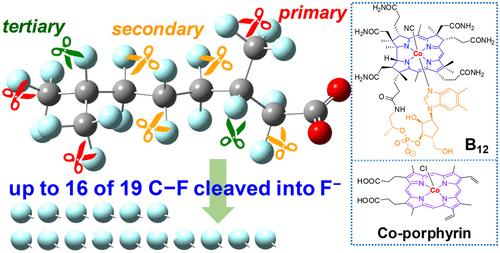当前位置:
X-MOL 学术
›
Environ. Sci. Technol. Lett.
›
论文详情
Our official English website, www.x-mol.net, welcomes your
feedback! (Note: you will need to create a separate account there.)
Reductive Defluorination of Branched Per- and Polyfluoroalkyl Substances with Cobalt Complex Catalysts
Environmental Science & Technology Letters ( IF 8.9 ) Pub Date : 2018-04-06 00:00:00 , DOI: 10.1021/acs.estlett.8b00122 Jinyong Liu 1 , Daniel J. Van Hoomissen , Tianchi Liu 1 , Andrew Maizel , Xiangchen Huo , Seth R. Fernández 1 , Changxu Ren 1 , Xin Xiao 2 , Yida Fang , Charles E. Schaefer 3 , Christopher P. Higgins , Shubham Vyas , Timothy J. Strathmann
Environmental Science & Technology Letters ( IF 8.9 ) Pub Date : 2018-04-06 00:00:00 , DOI: 10.1021/acs.estlett.8b00122 Jinyong Liu 1 , Daniel J. Van Hoomissen , Tianchi Liu 1 , Andrew Maizel , Xiangchen Huo , Seth R. Fernández 1 , Changxu Ren 1 , Xin Xiao 2 , Yida Fang , Charles E. Schaefer 3 , Christopher P. Higgins , Shubham Vyas , Timothy J. Strathmann
Affiliation

|
This study investigates structure–reactivity relationships within branched per- and polyfluoroalkyl substances (PFASs) undergoing cobalt-catalyzed reductive defluorination reactions. Experimental results and theoretical calculations reveal correlations among the extent of PFAS defluorination, the local C–F bonding environment, and calculated bond dissociation energies (BDEs). In general, BDEs increase in the following order: tertiary C–F bonds < secondary C–F bonds < primary C–F bonds. A tertiary C–F bond adjacent to three fluorinated carbons (or two fluorinated carbons and one carboxyl group) has a relatively low BDE that permits an initial defluorination to occur. Both a biogenic cobalt–corrin complex (B12) and an artificial cobalt–porphyrin complex (Co-PP) are found to catalytically defluorinate multiple C–F bonds in selected PFASs. In general, Co-PP exhibits an initial rate of defluorination that is higher than that of B12. Neither complex induced significant defluorination in linear perfluorooctanoic acid (PFOA; no tertiary C–F bond) or a perfluoroalkyl ether carboxylic acid (tertiary C–F BDEs too high). These results open new lines of research, including (1) designing branched PFASs and cobalt complexes that promote complete defluorination of PFASs in natural and engineered systems and (2) evaluating potential impacts of branched PFASs in biological systems where B12 is present.
中文翻译:

钴配合物催化剂对支链全氟和多氟烷基物质的还原脱氟
这项研究调查了在经历钴催化的还原性脱氟反应的支链全氟和多氟烷基物质(PFAS)中的结构反应性关系。实验结果和理论计算揭示了PFAS脱氟程度,局部CF键环境和计算出的键离解能(BDE)之间的相关性。通常,BDE的增加顺序如下:三次CF债券<二次CF债券<一次CF债券。与三个氟化碳(或两个氟化碳和一个羧基)相邻的叔C-F键的BDE相对较低,因此可以进行初始脱氟。生物钴-卟啉复合物(B 12)和人工钴-卟啉复合物(Co- PP))被发现可以催化选定的PFAS中的多个CF键脱氟。通常,Co- PP的初始脱氟速率高于B 12。两种络合物都不会在线性全氟辛酸(PFOA;无叔CF键)或全氟烷基醚羧酸(叔CFDE太高)中引起明显的脱氟。这些结果开辟了新的研究领域,包括(1)设计分支的PFAS和钴络合物,促进天然和工程系统中PFAS的完全脱氟,以及(2)评估分支的PFAS对存在B 12的生物系统的潜在影响。
更新日期:2018-04-07
中文翻译:

钴配合物催化剂对支链全氟和多氟烷基物质的还原脱氟
这项研究调查了在经历钴催化的还原性脱氟反应的支链全氟和多氟烷基物质(PFAS)中的结构反应性关系。实验结果和理论计算揭示了PFAS脱氟程度,局部CF键环境和计算出的键离解能(BDE)之间的相关性。通常,BDE的增加顺序如下:三次CF债券<二次CF债券<一次CF债券。与三个氟化碳(或两个氟化碳和一个羧基)相邻的叔C-F键的BDE相对较低,因此可以进行初始脱氟。生物钴-卟啉复合物(B 12)和人工钴-卟啉复合物(Co- PP))被发现可以催化选定的PFAS中的多个CF键脱氟。通常,Co- PP的初始脱氟速率高于B 12。两种络合物都不会在线性全氟辛酸(PFOA;无叔CF键)或全氟烷基醚羧酸(叔CFDE太高)中引起明显的脱氟。这些结果开辟了新的研究领域,包括(1)设计分支的PFAS和钴络合物,促进天然和工程系统中PFAS的完全脱氟,以及(2)评估分支的PFAS对存在B 12的生物系统的潜在影响。











































 京公网安备 11010802027423号
京公网安备 11010802027423号